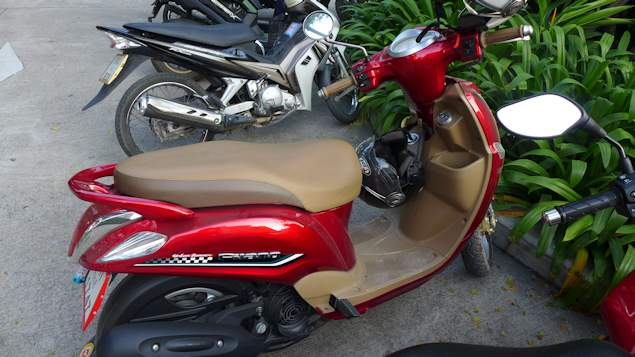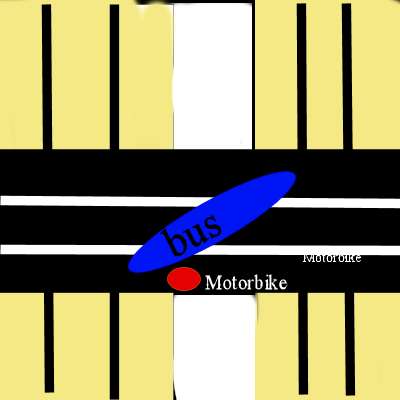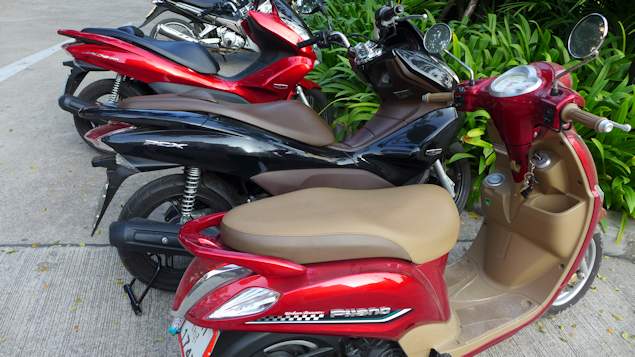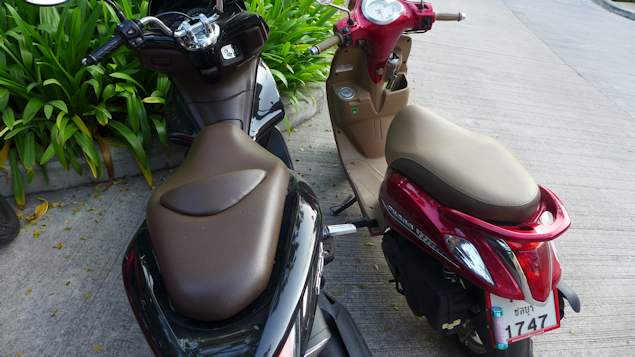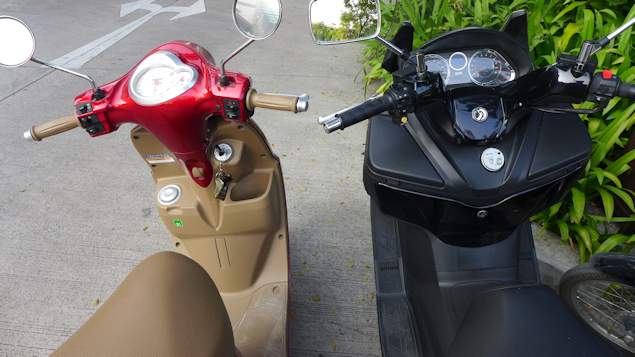|
Yamaha Filano Motorbike: The good, the bad and the Ugly
More beautiful than the Vespa that inspired it, the Yamaha Filano motorbike also comes with some notable limitations. By Jack Corbett
When one compares it to alternatives available to Thailand's motorbike market. This review will hopefully give you a comprehensive description of the small Yamaha's 1. Strong points, 2. Weaknesses, 3. Historical background, 4. Real world fuel economy and acceleration stats, and 5. Potential buyers I can personally recommend this bike to. Click here for video review on the Jack Corbett Video Channel
Historical Background It all started with the Second World War which left Europe devastated with the economies of the vanguished nations in total ruin and their citizens wondering where their next meal would come from let alone being able to afford automobiles. With gasoline being horrifically expensive, Italians who had wound up on the losing side longed for a way to get around faster and much easier than on foot or bicycle. Their salvation came in the form of an innovative motorscooter designed by Enrico Piaggio in 1946, just one year after the war's end. As for the name, the story goes that Piaggio upon seeing a prototype for the first time, exclaimed "Sembra una vespa!" (It resembles a wasp!) The first Vespas augered in a plethora of innovations such as a unitized exterior that completedly separated the scooter's mechanicals from its riders and an engine that was coupled directly to the bike's transmission that eliminated all that oily mess coming that is produced by chain driven motorcycles. With its floorboard and front cowling, riders' feet and legs were shielded from water splashing which traditional motorcycles equipped with foot pegs were unable to deal with. With a 98 cc. two stroke engine, small diameter 8 inch wheels and tires, light weight and short wheelbase the Vespa was cheap to operate, manueverable and easy to park practically anyhere. It was the urban transit dream come true. The icing on the cake was that it was cute while being utterly unlike real motorcycles such as Harleys and Triumphs that became associated with motorcycle gangs, especially after Marlon Brando and Lee Marvin and their unsavoy outlaw friends terrorized a small town in the 1953 film, "The Wild One". My first introduction to motorscooter came from my father, who had owned Harley's in the 1940's, and who was clearly prejudiced against them. "All motorcycles are dangerous he had told me, but these little motorscooters are especially worthless because their very small tires make them very unstable." Dad had certainly earned his right to make such statements having once ridden behind two Harley riders he had just had a beer with in a tavern and watching them pass a car only to dead head directly into the car they had not seen suddenly looming up in front of them. The luckier of the two, the man riding behind the driver, wound up with broken legs and arms. As for the driver, the last Dad saw of him was half his head being detached from the other half after he went over the bike's bars and into the grill of the car. I was less than twelve years old back then. The other thing I vividly remember was Dad and I going to the state fair to watch the motorcycle races, but it was the demonstration of a motorcycle's ability to circumnavigate a circular platform at a nearly 90 degree angle that made the strongest impression upon me. The platform was perhaps thirty feet in diameter. Its walls were straight up and down. Amazingly the motorcyclist was able to drive his machine around and around the platform until he was able to drive close to its top rim with his bike and head nearly horizontal to the floor. See that, my dad explained to me. The motorcycle is operating like a gyroscope. It's centrifical force that is holding it up against the wall like that. It's the speed and weight of the bike and the large size of its tires that make it stable enough to do that. Now more than fifty years later after reading up on the subject I'm not at all sure what the force is that makes some bikes more stable than others, whether it's centrifical or centrifugal force. The description of the physics behind it all gets very complicated. But one thing I do know is that motorscooters such as the Vespa and the Yamaha Filano that is the subject of this review do not conjure up nearly the centrifical or centrifugal force that some of its competitors offer. Even today, a Vespa still offers only 10 inch diameter wheels while the look a like Yamaha Filano rides on 12 inch wheels which are not nearly as large as the 16 inch wheels on my Yamaha Nouvo Elegance. But what the hell, people will buy anything won't they? And I'm just as guilty as the next guy, except I know better, and still I bought a Yamaha Filano. I bought it for my girlfriend, but before you throw stones at me for being so weakminded as to give in to the whims of a woman, I want you to listen up. I knew better. I had read up on how Honda completely revolutionized the motorcycle-motorscooter industry when it introduced its new underboned styled Cub which did away with the floorboard which it largedly replaced with a brace that rigidly riveted the rear and forward components of the motorbike together. This arrangement permitted much larger diameter wheels and tires thus offering much better stability and handling. In the 1960's Honda's Super Cub was a revolutionary design that in many ways antiquated the motor scooter designs of the past, including Vespa. I quote from Wikipedia http://en.wikipedia.org/wiki/Honda_Super_Cub
Whereas a Vespa has its engine and transmission up against the rear wheel towards the rear of the scooter, modern Vespa look-a-likes such as the Yamaha Filano place the engine in the center of the bike. To do this Yamaha and other manufacturers such as Honda employ a heavy duty drive belt to drive the rear wheel in an arrangement that permits a much more centralized location for the engine thus permitting a much more balanced (close to 50-50) weight distribution. Although some might prefer a chain driven manual transmission, the belt driven units are fully automatic and are typically good for 20,000 to 30,000 kilometers before they need to be replaced. Until then they are virtually maintenance free, and when the belt eventually gives out, it can easily be replaced for around $30.00. Compared to modern belt driven look alikes such as the Yamaha Filano, Yamaha Fino, and Honda Scoopy, I would think a Vespas handling would be inferior due to the extreme rearward position of the engine that directly drives the rear wheel and the overly small diameter wheels of the Vespa. But for that matter, I believe the handling of such look a likes is inferior to a Yamaha Nouvo Elegance. For example, a Yamaha Fino uses a 14 inch diameter tire that is specified at 14-70/90 in the front and 14/80/90 for the rear. But although it is using fatter tires, a Vespa 150 only has an 11 inch diameter tire on the front and a 10 inch diameter on the rear. Honda's modernized version of the Vespa, the Scoopy comes in at a scant 91 kilograms, has a 14 inch 70/80 front tires and a 14 inch 80/90 tire on the rear. Both have around 8.5 horsepower, which puts them in the same class as the 113 c.c. Nouvo MX, which gave way to the outstanding water cooled 135 c.c. Nouvo Elegance with its 11.2 horsepower engine. To my way of thinking neither the Yamaha Fino or Honda Scoopy can begin to compare with the likes of a Nouvo Elegance, with its much more potent engine and superior bracing or the 125 c.c. Nouvo fuel injected SX that replaced it, that give them unexcelled handling in the 125 c.c. motorbike class. A major problem in my opinion with all Vespas and Vespa look a like scooters is all employ a floorboard that although it provides a lot of room for feet and a grocery bag or two only utlilizes a single brace beneath the floorboard. As a result chassic rigidity is compromised. Moreover, both the Fino and Honda's Scoopy have only one rear shock absorber,which is a cheapie arrangement that will not do a good job in many real world conditions. These things were put on the market by both Honda and Yamaha to sell rather than to perform. They rely on the classic appeal of the Vespa with its Italian stylish mystique. Without question the Vespa has beautiful lines and can be counted a classic of a bygone area. For that matter, the Yamaha Fino in particular has even better styling than the classic that inspired it while the Honda Scoopy falls a bit short of the mark set by Yamaha. Unfortunately most Scoopys and Finos fall well short of what they could be due to the godawful cosmetics imposed on them by Asian designers who garbage up their creations with far too many decals and multi colored paint schemes. The question is, if scooter Vespa look alikes are such inferior performers what in God's name possessed me to buy a Filano for my girlfriend? As for what a Filano is, let's just call it a derivation of Yamaha's exellently styled Fino that out Vespaizes its parent. For one thing, it has even smaller wheels than the Fino, measuring just 12 inches in diameter. So it's a little lower to the ground with a slightly shorter wheelbase than the Fino. It also came out with fuel injection from the get go. Its main advantage over the Fino is that it has a much larger storage space underneath the rear seat which makes it a superior vehicle for hauling groceries home from the supermarket. Because of this decisive advantage I chose the Filano over its sibling because this left me free to later on choose a less practical bike over my 135 Elegance because we'd still have an eminently practical bike for our shopping. Even so, I would have much prefered buying my girlfriend a Yamaha 125 Nouvo SX, and would have whether she wanted one or not. In fact I was fully prepared to give her a choice beween say a Nouvo SX at an out the door price of around 58,000 baht or a Honda PCX at 80,000 baht as a take it or leave it propostion. Both bikes are much safer to drive due to their more rigid contruction, twin rear shocks, and greater weight as well as being signficantly more powerful. But I bought her what she wanted and I did this for one reason. I knew my girlfriend would never drive her new motorbike more than 2 kilometers from home and that she'd stay off the main roads. You see, my girlfriend is utterly terrified of motorbikes or at least the insane idiots we have driving here in Pattaya. With her healthy instinct for self-preservation, I was certain that she'd confine all her driving to the much less trafficked nearby back roads.
It really is a little jewel though
Honda seems to have a reputation around this neck of the woods for being able to do no wrong. Thais in particular regard Honda as a better quality product than anything built by Yamaha, Suzuki or Kawasaki. But I do remember my Dad telling me a few years after Honda had started taking the U.S. market by storm with its well engineered high quality motorcycles, "As good as Honda is, Yamaha makes an even better motorcycle." And as usual, my Dad turned out to be right--at least to my way of thinking. My girlfriend's Filano truly is a little jewel. Its engine starts right up without hesitation, and it's very quiet. All its controls are in just the right place, such as the turn indicators and it just is so smooth in every respect. The Filano's brakes are well modulated while being an absolute pleasure to use. And unlike two Honda Clicks I recently rented, the seat latches precisely and securely just as it should.
Roadtest It was time to put the Filano through several test loops. To test the bike's fuel economy, I tried to duplicate as closely as possible the same conditions I put the Honda Click, Yamaha SX and Yamaha Elegance 135 through. This meant driving up Naklua Road to Beach Road, down and through Walking Street past the Bali Hai pier, through Praternack and onto Jomtien where I took the road along the beach about as far as I could, and then back to my condo on Wongamat Beach. This was all city driving, although I wouldn't call it the real heavy city driving I oftentimes encounter. For one thing I did this loop in the mornings when the traffic was comparatively light. Furthermore, I'd do this test loop all at one shot, while performing it twice over two our three days. This meant very little of that constant starting and stopping the bike's engine which undoubtedly takes its toll on fuel economy. I also included a segment of relatively fast highway driving that started with a run down Sukamvit to route 36 where I drove the little bike to Pattaya's driver's license and vehicle services center near the International School. Although I didn't check the odometer for this highway segment I'd estimate it at roughly 20 miles round trip. On route 36 I did two acceleration runs to 50 kilometers per hour, using the new Seiko stopwatch I had bought from Amazon, and then I recorded the results in a small notebook. I would have prefered to do more. But I didn't even consider doing a timed test to 80 kilometers per hour. My reasoning was two-fold. First, I always take my Nouvo Elegance over my girlfriend's Filano when I drive more than a couple of kilometers from home due to its far superior road manners, especially with its larger than stock tires, and second, because of the homicidal driving of way too many Thai drivers compounded with the total lack of police enforcement over this areas streets and highways. At this point I find it necessary to bring up a single incident to point out how absolutely insane the driving is here.
|
|
I am not a timid driver. I used to drive my 90 horsepower BMW K 100 RS motorcycle over 100 miles an hour on poorly surfaced two lane roads and once hit over 130 miles an hour testing my bike's top speed when I had to back off when an overhead loomed in front of me. I even turned a four hour drive from my farm to Chicago with my now ex wife behind me into a 2 1/2 hour jaunt and blew off a Camero Z-28 which started to screw with us. Although the newest BMW's are much faster now, that K-100 RS didn't start to feel right until I took it to at least 80 miles an hour and it could accelerate from Zero to one hundred miles an hour in 7 seconds while managing a top end of 140 miles an hour. But that was pretty sedate stuff back in those days compared to what it's like driving small motorbikes in Pattaya, and believe me, while trying to do stop watched acceleration runs on the highway on a small motorbike is an exercise in very bad judgment. But, to make these road tests happen I simply have to do it. Although I have put the Yamaha Filano down at 8.35 horsepower, I am not quite sure of that. I have been completely unable to find any horsepower figures on the internet for the Filano and whenever I have come up with this bike's specifications I've always come up with a case of Monkey see, monkey do. That is everyone's using someone else's figures for this bike's specifications. But me? I'm no monkey so I've decided to estimate the bike's horsepower as best as I'm able. I have found figures on the internet for the 115 c.c. Fino given at 8.25 horsepower. So the way I'm figuring it is given the fact that the Filano and this particular model of Fino use the same displacement engine I see no particular reason for Yamaha to makes on bike's engine more or less powerful than the other. Be that as it may, my girlfriend's Filano did compile better zero to fifty kilometer numbers than the 125 c.c. Yamaha SX I had tested earlier even though it's way down the chart when it comes to raw horsepower numbers. I do not feel that it would arrive at 80 kilometers per hour as quickly as the Nouvo SX is capable of doing however. Once again, it appears to me that the SX is tuned in such a way to provide maximum fuel economy in city driving at the expense of low end acceleration. However, once you turn the throttle up on the 125 SX, acceleration starts to build and build so the effect is altogether very satisfying even though it's a far cry from the sling shot acceleration of a 125 c.c. Honda Click or 135 c.c. Yamaha Elegance. The little 113 c.c. engine used in the Filano is simply not going to measure up to what the 125 c.c. Nouvo SX is capable of. You will notice also that the Filano even though it's got a smaller engine than the 125 Nouvo SX, that it did not do as well for fuel economy. The difference is small, but it's there nevertheless. Perhaps if I had done an entire month's driving each bike the Filano might have come out on top. Notice also that in spite of its much bigger engine, the carburated 135 c.c. Nouvo Elegance isn't really that much far behind either the Filano or the Nouvo SX.
In the Parking Lot
So where does the Filano fit in here in Pattaya, Thailand where I've been living for the past 8 years?
To my notion, as long as one perceives the Yamaha Filano as a
glorified golf kart, it should fit in as long as you understand its
limitations.
|
|
|
